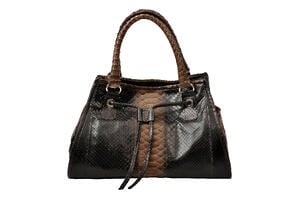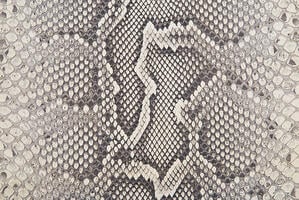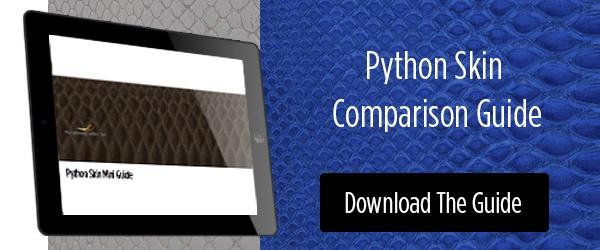 Welcome to our finale on python skins! First, we had a brief overview of the three most commonly-traded python skins, then we had a more in-depth look at each of the three. Today, we’ll be doing some direct comparisons between the three so that you can choose the right type of python skin for you next exotic leather project.
Welcome to our finale on python skins! First, we had a brief overview of the three most commonly-traded python skins, then we had a more in-depth look at each of the three. Today, we’ll be doing some direct comparisons between the three so that you can choose the right type of python skin for you next exotic leather project.
Comparing Measurements
Of the three python skins that are commonly available commercially, the Brongersmai, or short tail python, is the smallest. The average measurement of the short tail python is roughly 1.6 meters in length and 28 cm wide at the center, tapering down to 15 cm wide at the ends. Generally speaking, this means that you can expect to get roughly 5 sq. ft. of hide from the average short tail python skin.
The Burmese python’s hide is much larger than that of the short tail python. On average, the skin of a Burmese python, or python bivitattus, measures 3.25 meters long and is 28 cm wide at the widest point of the belly. When you purchase an average-sized Burmese python skin, you’ll probably get around 10 sq. ft. of hide to work with.
The diamond python’s skin, interestingly enough, has the same measurements as that of the Burmese python’s skin for average length and width at the center. However, the diamond python tends to have a slightly smaller yield per skin than a Burmese python because it tapers more severely from the center to the ends.
Another difference between the three hides is their thickness. The Burmese python has a thinner hide than the other two species of python mentioned here. This makes the hide of a Burmese python easier to flex than the others. Additionally, the Burmese python should be easier to sew, as needles will pass through the thinner hide more easily than they would with the other types of python leather.
Comparing Appearances
 The hide of the Burmese python features large, rounded color patterns arrayed in a somewhat random fashion. The hide of the diamond python skin has more geometric, net-like patterns. Another telltale sign that a skin is a Burmese python skin instead of a short tail or diamond python skin is that the Burmese python’s center belly scales are much narrower than those of the other two snake species.
The hide of the Burmese python features large, rounded color patterns arrayed in a somewhat random fashion. The hide of the diamond python skin has more geometric, net-like patterns. Another telltale sign that a skin is a Burmese python skin instead of a short tail or diamond python skin is that the Burmese python’s center belly scales are much narrower than those of the other two snake species.
Telling diamond python skin from short tail python skin, on the other hand, can be a little trickier if both skins are bleached. Currently, short tail python skin is only available in a back-cut, bleached style, so skin in that style and cut with wide belly scales could be from either type of python.
The two telltales that a given bleached back-cut skin is from a diamond python rather than a short tail python are:
-
Length of the hide. Remember, the average short tail python skin is only 1.6 meters in length, whereas a diamond python hide averages 3.25 meters, or double the length.
-
Tapering of the hide. A diamond python’s skin tapers more severely from the center to the ends than the skins of the other two python species. If you lay down a diamond python hide next to a short tail python hide of equal length, then the diamond python skin will become skinnier noticeably faster than the short tail skin does.
Using these two distinctive factors, you can differentiate a back-cut bleached diamond python hide from a similar short tail python hide.
Types of Projects Each Hide is Suitable for
 When choosing between the three kinds of python hide for an exotic leather project, here are a few ideas for project types that each hide might be suitable for:
When choosing between the three kinds of python hide for an exotic leather project, here are a few ideas for project types that each hide might be suitable for:
-
Belts. Any of the python skins can be used for exotic leather belts quite easily. For larger belts, however, Burmese and/or diamond python hides are your best option.
-
Boots/Shoes. For footwear projects, consider using either short tail or diamond python hide for boots and heavy-duty footwear that should be stiff. Burmese python hides can be used for more flexible footwear, as their thinner hide flexes a bit more easily.
-
Furniture. Celebrities such as Elton John have used python hides to add some personality to their furniture and bedding. For such large items, the 3 meter or longer skins of the Burmese or diamond pythons are typically best.
-
Garments. For garment items, Burmese python hides are the best. These skins not only come in the massive sizes needed for garment panels, they also are thinner than the other skins on this list. This thinness is a must for garments, which have to bend and flex with the wearer.
-
Handbags. Any of the three hides might prove suitable for use in handbags. Even the short tail python, being half as long as the others, is still plenty large enough to fill the panels for a handbag project.
-
Luggage. For these large-scale projects, Burmese and diamond-python hides are your best bet to fill the large panels these items require.
-
Wallets and small accessories. If you’re making wallets, any of the python hides can be used to make several such items per hide. However, consider focusing on using short tail python hide if you’re only focusing on small accessory items, especially if you’re trying a new concept and want to experiment.
With any of these python hides, you can rest assured that you’ve got a top-shelf material for creating products that will delight the demanding tastes of your ultra-wealthy clients.
Wondering how you can work python skins into your next exotic leather project? Contact Pan American Leathers today for a free consultation using the link below:



